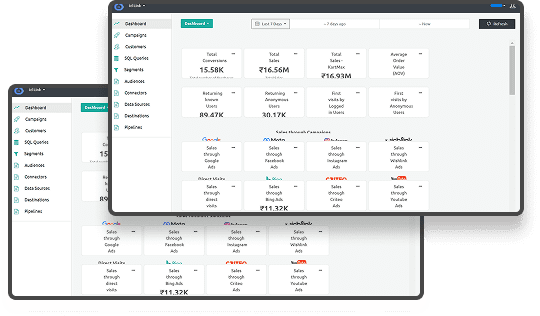Have you ever wondered how online ads know exactly what you are interested in?
Cookies and identity graphs are the secret tools behind those personalized ads. They help advertisers understand and reach their audience effectively. With changes in privacy rules and the end of third-party cookies, companies like The Trade Desk are creating new ways to keep digital advertising accurate and efficient.
Learning how The Trade Desk syncs cookies and builds identity graphs can help businesses deliver better-targeted ads while respecting user privacy.
In this blog, we’ll explain cookies and identity graphs and how The Trade Desk uses them.
Before we explore how Trade Desk syncs cookies, it’s important to understand what cookies are and why they’re essential in digital marketing.
What are Cookies in Digital Advertising?
Cookies are small pieces of data stored on a user's device when they visit a website. These cookies track the user’s behavior, such as the pages they visit, products they view, and even their preferences. Different types of cookies exist, including session cookies and persistent cookies, which help track users either temporarily or over a longer period.
For digital marketers, cookies are indispensable because they enable us to track user behavior and target them with personalized ads. However, there’s a catch. Third-party cookies, which have been the cornerstone of tracking, are being phased out due to privacy concerns and regulations like GDPR and CCPA.
But how does the Trade Desk tackle this challenge and continue providing effective targeting? To answer this, we must explore identity graphs and how they work with cookies. Explore more about third-party cookies and their challenges here.
To understand how Trade Desk syncs cookies effectively, we also need to explore what identity graphs are and why they matter.
What is an Identity Graph?
An identity graph is a data structure that helps marketers link a user’s identity (ies) across multiple devices and platforms. For example, a user might visit a website on their phone and later switch to their desktop computer. On the phone, they have shared their phone number, and on the Web, they have tied their email ID. An identity graph ensures that both devices and IDs are linked to the same user, allowing marketers to track the user's journey accurately.
In simpler terms, identity graphs help build a more complete picture of your audience by combining different data points, such as:
- Device information: Linking a mobile device to a desktop.
- User behavior: Tracking actions across multiple channels.
- Cross-platform behavior: Connecting interactions across websites, apps, and social media platforms.
Building these graphs ensures that advertisers can follow users wherever they go and serve relevant ads at the right moment. But how does The Trade Desk play a role in this?
Learn how identity graphs impact cross-channel targeting in digital marketing.
With Ingest Labs’ Ingest ID, building identity graphs becomes even easier. Ingest ID employs advanced probabilistic and deterministic matching techniques to reconcile identifiers like email addresses, phone numbers, and device IDs across platforms. This approach ensures a cohesive and accurate view of each customer, leading to more effective engagement strategies.
Now that we know the basics of cookies and identity graphs let's see how Trade Desk connects these pieces to match cookies.
How Trade Desk Matches Cookies
Trade Desk is a global advertising technology platform that helps advertisers with targeted ads. One of its key capabilities is cookie syncing—the process of matching and linking cookies across different websites and devices.
Here’s how Trade Desk uses cookies to enhance ad targeting:
- Tracking Users Across Platforms: When a user visits a website, The Trade Desk places a cookie on the user’s device. This cookie then helps track the user’s behavior on other sites and apps. Through cookie syncing, Trade Desk can ensure that the same user is recognized across multiple touchpoints (e.g., desktop, mobile, tablet).
- Syncing Cookies with Third-Party Data Providers: Trade Desk doesn’t only rely on first-party cookies; it also syncs data with third-party data providers to create a broader and more accurate picture of the user. This process helps marketers reach users based on their interests, past purchases, and behavior across different platforms.
- First-Party vs. Third-Party Data: By syncing first-party and third-party cookies, Trade Desk helps ensure marketers have the most accurate information possible about their audience. First-party data comes directly from the user, while third-party data is collected from external sources, giving a broader view of the user and their browsing patterns.
Want to learn how first-party data improves personalization? Check out this blog.
Once cookies are matched, building identity graphs takes the process further—let’s see how Trade Desk does this.
The Process of Building Identity Graphs with Trade Desk
Building an identity graph requires data and a lot of it. But the Trade Desk’s technology enables advertisers to gather and analyze this data effectively. Here’s how the process works:
- Data Collection: Trade Desk collects data from various sources, such as website visits, app usage, and ad interactions. This data includes user behaviors, browsing history, and even transaction details.
- Cross-Device Matching: One of the main challenges in digital advertising is tracking users across different devices. Trade Desk uses techniques like device fingerprinting and probabilistic matching to link user identities across multiple devices. This ensures that if a user visits a website on their phone and then later on their desktop, both sessions are attributed to the same user.
- Integrating External Data: To enhance the accuracy of identity graphs, Trade Desk integrates data from external sources, such as CRM systems, email lists, and even social media platforms. This ensures that the identity graph provides a comprehensive view of the user’s behavior and preferences. Interested in CRM data integration? Learn how Ingest Labs integrates first-party data.
By integrating Ingest ID, marketers can achieve a unified understanding of customer behaviors and preferences, leading to better-targeted ads.
Now that we know how identity graphs are built, let’s explore their importance in delivering better ad targeting.
The Role of Identity Graphs in Ad Targeting
Now that we understand how Trade Desk builds identity graphs let’s look at how these graphs play a pivotal role in ad targeting.
- Personalized Ads: Using identity graphs, Trade Desk helps advertisers deliver personalized ads. If you’ve ever seen an ad for a product you recently viewed, it’s because the advertiser uses data from your identity graph to serve relevant ads.
- Cross-Channel Targeting: Identity graphs allow advertisers to reach the same user across multiple devices. Whether a user is browsing on their phone, tablet, or desktop, Trade Desk ensures that they receive consistent and relevant ads, improving the chances of conversion.
- Increased ROI: When advertisers target the right user with the right message at the right time, they’re more likely to see higher engagement and conversions. This leads to a better return on ad spend (ROAS).
By integrating Ingest ID into your marketing strategy, you can significantly improve your ability to personalize ads. With a more unified and accurate view of your customers, you can ensure that your campaigns are targeting the right individuals at the right time.
Finally, let’s look at some of the challenges involved in syncing cookies and building identity graphs effectively.
Challenges in Syncing Cookies and Building Identity Graphs
Despite the advantages, there are challenges when it comes to syncing cookies and building identity graphs:
- Privacy Concerns: Data privacy regulations like GDPR and CCPA have made collecting and syncing user data more difficult. Advertisers must ensure user consent and be transparent about using personal information.
- Accuracy Issues: Matching users across devices isn’t always 100% accurate. Users may have different accounts or use multiple devices with different IDs, creating a single, accurate identity graph challenging.
- Data Overload: With so much data coming from various sources, managing and organizing it can be overwhelming. Ensuring that the data used for identity graphs is clean and accurate is key to successful targeting.
Ingest Labs helps solve many of these issues by offering advanced server-side tracking and first-party identity solutions, improving the accuracy and quality of data collection. Server-side tracking can enhance customer behavior insights, ensuring that your identity graph is built on reliable data.
Check out how GDPR and CCPA affect digital advertising.
Conclusion
As digital advertising continues to evolve, syncing cookies and building accurate identity graphs are crucial for delivering personalized, effective marketing campaigns. Trade Desk plays a key role in this process by leveraging advanced data collection, matching techniques, and cross-device tracking to ensure that users are identified consistently across multiple platforms.
However, integrating solutions like Ingest Labs’ Ingest ID becomes essential with the increasing importance of user privacy and data accuracy. Using advanced matching techniques and prioritizing first-party data, Ingest ID helps marketers build more accurate identity graphs while ensuring privacy compliance and reducing data inconsistencies.
Ready to take your marketing strategies to the next level? Get in touch with our team to learn more about how we can help you leverage first-party data and build accurate identity graphs for your business.






